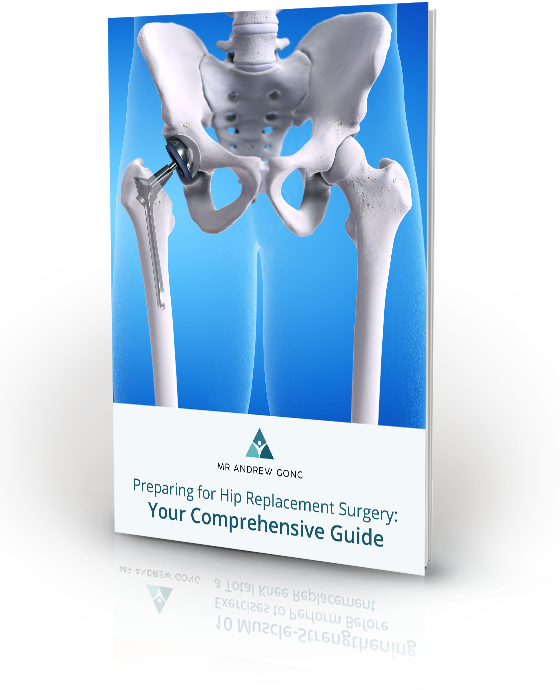Hip replacement surgery is a major surgical procedure that can help alleviate pain and restore mobility in people with severe hip joint damage.
The procedure involves replacing a damaged hip joint with an artificial hip joint, known as a prosthesis and is typically recommended for people who are experiencing hip pain that is not relieved by non-surgical treatments.
If you have been experiencing hip pain, unable to find permanent relief, consider booking a consultation with Mr Andrew Gong, a hip replacement surgery specialist based in the Melbourne area.
Preparing for Hip Replacement Surgery: Your Comprehensive Guide
Prepare yourself for a successful hip replacement surgery. From understanding the procedure and pre-surgery preparations to post-operative care and recovery exercises, this guide empowers you with the knowledge and tools needed for a smooth and confident journey.

What is a hip replacement?
A hip replacement is a surgical procedure to replace a damaged hip joint with an artificial joint. The procedure involves the removal of the damaged joint and the insertion of an artificial joint called a prosthesis.
The prosthesis is usually made of metal and plastic components that are designed to closely mimic the function of a normal hip joint. The goal of hip replacement surgery is to improve mobility and reduce pain in people who have severe hip joint damage.

Relieve pain experienced in the hip with a hip replacement
surgery with Mr Andrew Gong in Melbourne.

Hip replacement prosthetics are typically made of metal or plastic.
Signs & symptoms you may need a hip replacement
In some cases, your doctor may recommend hip replacement surgery if you experience any of the following symptoms:
- Persistent hip pain affecting the quality of life
- Difficulty moving the hip joint
- Loss of range of motion in the hip joint
- Stiffness and pain in the hip joint
- Difficulty climbing stairs, walking and standing
- A grating or grinding sensation in the hip joint
Swelling and inflammation in the hip joint - Difficulty sleeping due to hip pain
- A limp or change in the way you walk
- Visible deformity in the hip joint
- Hip arthritis sufferers
Types of hip replacements available
There are several types of hip surgeries available, and the doctor will recommend the surgery that will assist with the patient’s knee condition.
Total Hip Replacement Surgery (THR)
This is the most common type of hip joint replacement surgery. It involves removing the damaged hip joint and replacing it with an artificial joint made of metal and plastic.
Partial Hip Replacement (PHR)
In this procedure, only the ball-and-socket joint is replaced. The hip socket and the thighbone (femur) are left intact.
Resurfacing Hip Replacement (RHR)
This procedure is similar to partial hip replacement, but instead of replacing the ball-and-socket joint, only the ball is replaced with a metal cap.
Hemiarthroplasty
This procedure is used to treat hip fractures. It involves replacing the ball of the hip joint with a metal prosthesis.
Hip Replacement Revision Surgery
The hip replacement revision procedure to replace a previously implanted hip joint that has worn out or becomes infected.
Anterior Hip Replacement Surgery
The anterior approach hip replacement surgery is a new approach to a traditional hip replacement. This procedure is minimally invasive and involves a small 3-4 inch incision on the front of the hip, allowing the joint to be replaced by moving the muscles without the detachment of any tendons. A minimally invasive posterior approach may be a more suitable approach for some patients and still offers an enhanced recovery. The risks and benefits wil be discussed.

Once the hip replacement is performed, a patient should be able to return to some light daily activities within six weeks.
How is a hip replacement procedure performed?
The exact procedure for hip replacement surgery can vary depending on the patient’s needs and the type of hip surgery being performed. Generally, hip replacement surgery is performed in an operating room under spinal anesthesia.
The surgeon will make an incision over the hip joint and remove the diseased or damaged hip joint. The femur (thigh bone) and the acetabulum (hip socket) are both prepared to receive the artificial components.
The artificial components, which are typically made of metal or plastic, are then fixed in place with either cement or special coatings that allow for a “biologic” bond between the bone and the implant.
The artificial components are then tested to make sure they are properly positioned and functioning correctly. The incision is then closed using sutures or staples.
Hip replacement surgery post-operative
recovery and results
Recovery from hip replacement surgery can vary depending on the patient’s overall health and the type of surgery performed. Generally, patients are encouraged to take it easy for the first four to six weeks following their surgery to allow the incision to heal and to ensure that they do not overexert themselves.
After a few weeks, most patients can gradually return to their normal activities. In most cases, patients will experience significant improvement in their mobility and pain levels after having a successful procedure.
Physical therapy is often recommended to help patients regain strength and range of motion in the hip joint. It is important to follow the instructions of the physical therapist and to practice the exercises regularly to ensure the best possible outcome.
Additionally, patients should be aware of any signs of infection or other complications that may arise after surgery and contact their doctor if they experience any concerning symptoms.
Hip replacement
risk to consider
As with any major surgical procedure, there are risks associated with having a hip replacement. These include:
- Infection
- blood clots
- nerve damage
- loosening of prosthetic components
- loosening of bone around the implant
- difference in leg length
- deep vein thrombosis
It is important to discuss these risks with your doctor before deciding to undergo a hip replacement procedure.

Hip replacement surgery is a common procedure performed to assist patients with hip conditions to regain natural, pain-free hip movement.
Am I a candidate for hip replacement surgery?
Your doctor will help determine if you are a candidate for hip replacement surgery based on your individual situation.
Generally, this procedure is reserved for people who have severe hip joint damage which is causing disability and pain that cannot be controlled by non-surgical treatments.
Your doctor may take into account the following factors related to your overall health before recommending this procedure:
- age
- activity level
- general health and fitness
- lifestyle
How much does hip replacement surgery cost
Hip replacement surgery costs at any of our Melbourne clinics will depend on which hip surgery has been recommended for your individual hip condition.
Mr Andrew Gong will conduct a thorough assessment which may include X-rays or scans, and can then provide a detailed quotation.
This quotation will include pricing of the treatment and a surgical procedure including the pricing for the hospital stay and the anesthetist. We will also advise if any rebates apply for Medicare or any other health insurance.
How can Mr Andrew Gong can help
with your hip replacement
Mr Andrew Gong is an experienced orthopaedic surgeon who is fellowship trained in hip reconstruction. He is experienced in the use of cutting-edge technology and techniques, including minimally invasive and robotic-assisted surgery.
He is able to provide comprehensive medical care, including diagnosis, treatment and rehabilitation, to patients to return them to their normal daily activities.

Meet Mr Andrew Gong
MBBS, FRACS (Orth), F.A.Orth.A
Mr Andrew Gong is a highly skilled orthopaedic surgeon in Melbourne, with over two decades of experience in hip replacement surgeries. He is a fellow of the Australian Orthopaedic Association (AOA), a fellow of the Royal Australasian College of Surgeons (RACS) and an overseas affiliate member of the American Academy of Orthopaedic Surgeons.
How to schedule a consultation
If you would like to schedule an appointment to see Mr Andrew Gong, please do so via the following methods:
Our Locations
- Box HillEpworth Eastern, East Wing Tower
Level 14, Suite 14.3
25 Nelson Road, Box Hill VIC 3128
- HealesvilleGet Well Clinic
408 Maroondah Hwy
Healesville VIC 3777, Australia
- RichmondMelbourne Bone and Joint Clinic
27 Erin Street
Richmond VIC 3121, Australia
Frequently Asked Questions
If you require more information on hip replacement surgeries within the Melbourne area, please review our most
frequently asked questions section. If you still need more detailed information please feel free to contact us directly.
What is the best age for hip replacement?
The best age for hip replacement depends on the individual and their overall health. Generally, most people are considered good candidates for hip replacement after age 50, though some may benefit from the procedure at a younger age.
When can I go home after surgery?
Depending on the type of hip surgery, a patient will typically stay in the hospital for 2 to 5 days. After that, a patient can go home and start physical therapy. Most people are able to return to their daily activities within six to eight weeks.
Are there any risks and complications?
Although not typical, there are risks and complications associated with hip replacement surgery, which include infection, dislocation, loosening, fractures, nerve and blood vessel damage, and blood clots. Other rare complications include pain, stiffness, and leg length discrepancy.
When can I drive after surgery?
It is recommended that you do not drive for at least four weeks after hip replacement surgery. You should only drive if you can do so safely with no pain or discomfort. You should also be able to move your leg easily and have full control of the vehicle.
Is hip joint replacement a major surgery?
Yes, hip joint replacement is major surgery. The procedure is typically done under general anesthesia, and it involves replacing the damaged joint with an artificial one, which is attached to the surrounding bone. Recovery time can vary, but it usually takes several weeks to heal fully.




